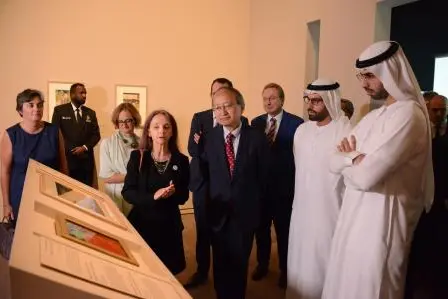PHOTO
Abu Dhabi: HH Mohamed Khalifa Al Mubarak, Chairman of the Department of Culture and Tourism – Abu Dhabi (DCT Abu Dhabi), officially opened Louvre Abu Dhabi’s latest exhibition Japanese Connections: The Birth of Modern Décor on Wednesday September 5th. The opening of the exhibition was attended by HH Omar Sultan Al Olama, Minister of State for Artificial Intelligence, HE Saif Saeed Ghobash, Undersecretary of DCT Abu Dhabi, and a number of ambassadors to the UAE, including the French Ambassador Ludovic Pouille, Kanji Fujiki, Japanese Ambassador to the UAE, Mexican Ambassador Francisca Mendez, Fernando Ramon De Martinez, Ambassador of Argentina, Spanish Ambassador Jose Eugenio Salarich, Tunisian Ambassador Samir Manser, Oman's Ambassador, Dr Khalid bin Said al Jaradi, and other officials and dignitaries.
In collaboration with Musée d’Orsay, the new exhibition showcases 50 paintings, prints and folding screens that explore the artistic and cultural dialogue between Japan and France.
Curated by Isabelle Cahn, General Curator of Paintings at Musée d’Orsay, the works of the 12 French and Japanese artists making up the exhibition have been assembled from the collections of Louvre Abu Dhabi, Musée d’Orsay, Musée national des Arts asiatiques - Guimet and Musée des Arts Décoratifs (MAD).
The exhibition will be accompanied by programming that celebrates Japanese arts and culture. The weekend of the exhibition opening will feature the Emirati-Japanese Kharsha Drums group, who will present traditional waikaido percussion performances played by Japanese and Emirati musicians. The programme will also offer film screenings curated by Hind Mezaina, a talk entitled ‘1,00o years of Manga’ exploring how Japanese traditions inspired the phenomenon, and a project with renowned street artist Myneandyours, whose collaboration with several UAE schools will be showcased in the museum. The programme culminates with a Big in Japan weekend including a spoken word event by award-winning Emirati Afra Atiq, and a performance by the Turntable Symphonograph Orchestra from Japan. The museum’s café will also feature a special Japanese-inspired menu.
-Ends-
Follow Louvre Abu Dhabi on social media: Facebook (Louvre Abu Dhabi), Twitter (@LouvreAbuDhabi) and Instagram (@LouvreAbuDhabi) #LouvreAbuDhabi
ABOUT LOUVRE ABU DHABI
Louvre Abu Dhabi is a universal museum on Saadiyat Island that exhibits art and artefacts from ancient times to the present day. Designed by French architect Jean Nouvel, the museum contains 12 chapters in the galleries, international exhibition spaces, a Children’s Museum, auditorium, restaurants, retail and a research centre. Surrounded by the sea, the buildings are connected by waterfront promenades beneath the museum’s stunning dome.
Louvre Abu Dhabi has developed a rich collection of works originating from throughout human history and around the world, brought together to highlight universal themes and influences. To date, Louvre Abu Dhabi has acquired more than 600 artworks, exhibited alongside 300 works on loan from 13 leading French institutions.
Louvre Abu Dhabi was born out of a unique intergovernmental agreement between the governments of Abu Dhabi and France in 2007. As part of the agreement, Louvre Abu Dhabi has access to expertise and training from 17 French partner institutions, as well as loans from 13 leading French museums for 10 years, and will benefit from international exhibitions organised by these institutions for 15 years.
ABOUT MUSÉE D’ORSAY
Located in an old railway station opened in 1900 before being refurbished for its current purpose, the Musée d’Orsay has been renowned worldwide since its opening in December 1986. Musée d’Orsay shows the great diversity of artistic creation in the western world between 1848 and 1914. Its multidisciplinary nature brings together all artistic fields: sculpture, painting, decorative art, art objects, architecture, drawing and photography. The museum’s collections include masterpieces by Monet, Renoir, Cézanne, Van Gogh, or Courbet, Rodin and Carpeaux that have brought it an international reputation, as well as recognition for its expertise in the history of art in the second half of the 19th century.
As one of Louvre Abu Dhabi’s museum partners, the Musée d'Orsay has lent artworks that are displayed in the museum’s galleries along with the Louvre Abu Dhabi’s permanent collection.
ABOUT AGENCE FRANCE-MUSÉUMS
Created in 2007 following the intergovernmental agreement between Abu Dhabi and France, Agence France-Muséums has been for 10 years a key link between France and the UAE in the accomplishment of the Louvre Abu Dhabi.
By gathering for the first time the collections and the expertise of the French cultural institutions involved, AFM has provided since its creation assistance and expertise to the authorities of the United Arab Emirates in the following areas: definition of the scientific and cultural programme, assistance in project management for architecture including museography, signage and multimedia projects, coordination of the loans from French collections and organization of temporary exhibitions, guidance with the creation of a permanent collection, and support with the museum’s policy on visitors.
AFM now continues its missions for Louvre Abu Dhabi after its opening with the training of the museum’s professionals, the coordination of loans from French museums for 10 years and the organisation of temporary exhibitions for 15 years.
Agence France-Muséums brings together the Louvre Abu Dhabi partner institutions: Musée du Louvre, Centre Pompidou, Musées d’Orsay et de l’Orangerie, Bibliothèque nationale de France, Musée du quai Branly-Jacques Chirac, Réunion des Musées Nationaux et du Grand Palais (RMN-GP), Château de Versailles, Musée national des arts asiatiques-Guimet, Musée de Cluny – musée national du Moyen-Âge, École du Louvre, Musée Rodin, Domaine National de Chambord, Musée des Arts Décoratifs (MAD), Cité de la Céramique – Sèvres & Limoges, Musée d’Archéologie nationale – Saint-Germain en Laye, Château de Fontainebleau, and OPPIC (Opérateur du patrimoine et des projets immobiliers de la culture).
ABOUT SAADIYAT CULTURAL DISTRICT
Saadiyat Cultural District on Saadiyat Island, Abu Dhabi, is devoted to culture and the arts. An ambitious cultural undertaking for the 21st century, it will be a nucleus for global culture, attracting local, regional and international guests with unique exhibitions, permanent collections, productions and performances. Its ground-breaking buildings will form a historical statement of the finest 21st century architecture; Zayed National Museum, Louvre Abu Dhabi and Guggenheim Abu Dhabi. These museums will complement and collaborate with local and regional arts and cultural institutions including universities and research centres.
About the Department of Culture and Tourism – Abu Dhabi
The Department of Culture and Tourism – Abu Dhabi conserves and promotes the heritage and culture of Abu Dhabi emirate and leverages them in the development of a world-class, sustainable destination of distinction that enriches the lives of visitors and residents alike. The Department manages the emirate’s tourism sector and markets the destination internationally through a wide range of activities aimed at attracting visitors and investment. Its policies, plans and programmes relate to the preservation of heritage and culture, including protecting archaeological and historical sites and to developing museums, including the Louvre Abu Dhabi, the Zayed National Museum and the Guggenheim Abu Dhabi. The Department of Culture and Tourism supports intellectual and artistic activities and cultural events to nurture a rich cultural environment and honour the emirate’s heritage. A key role played by the Department is to create synergy in the destination’s development through close co-ordination with its wide-ranging stakeholder base.
ABOUT MUSÉE DU LOUVRE
The Louvre in Paris opened in 1793, during the French Revolution, and from the very beginning was intended to provide inspiration for contemporary art. Courbet, Picasso, Dalí and so many others came to its hallowed halls to admire the old masters, copy them, immerse themselves in masterpieces and improve and fuel their own art. As an ancient royal residence, the Louvre is inextricably linked to eight centuries of French history. As a universal museum, its collections, among the best in the world, span many millennia and miles, from the Americas to Asia. Over 38,000 artworks are grouped into eight curatorial departments, including universally-admired works such as the Mona Lisa, the Winged Victory of Samothrace and the Venus de Milo. With 8.1 million guests in 2017, the Louvre is the most visited museum in the world.
© Press Release 2018Disclaimer: The contents of this press release was provided from an external third party provider. This website is not responsible for, and does not control, such external content. This content is provided on an “as is” and “as available” basis and has not been edited in any way. Neither this website nor our affiliates guarantee the accuracy of or endorse the views or opinions expressed in this press release.
The press release is provided for informational purposes only. The content does not provide tax, legal or investment advice or opinion regarding the suitability, value or profitability of any particular security, portfolio or investment strategy. Neither this website nor our affiliates shall be liable for any errors or inaccuracies in the content, or for any actions taken by you in reliance thereon. You expressly agree that your use of the information within this article is at your sole risk.
To the fullest extent permitted by applicable law, this website, its parent company, its subsidiaries, its affiliates and the respective shareholders, directors, officers, employees, agents, advertisers, content providers and licensors will not be liable (jointly or severally) to you for any direct, indirect, consequential, special, incidental, punitive or exemplary damages, including without limitation, lost profits, lost savings and lost revenues, whether in negligence, tort, contract or any other theory of liability, even if the parties have been advised of the possibility or could have foreseen any such damages.











